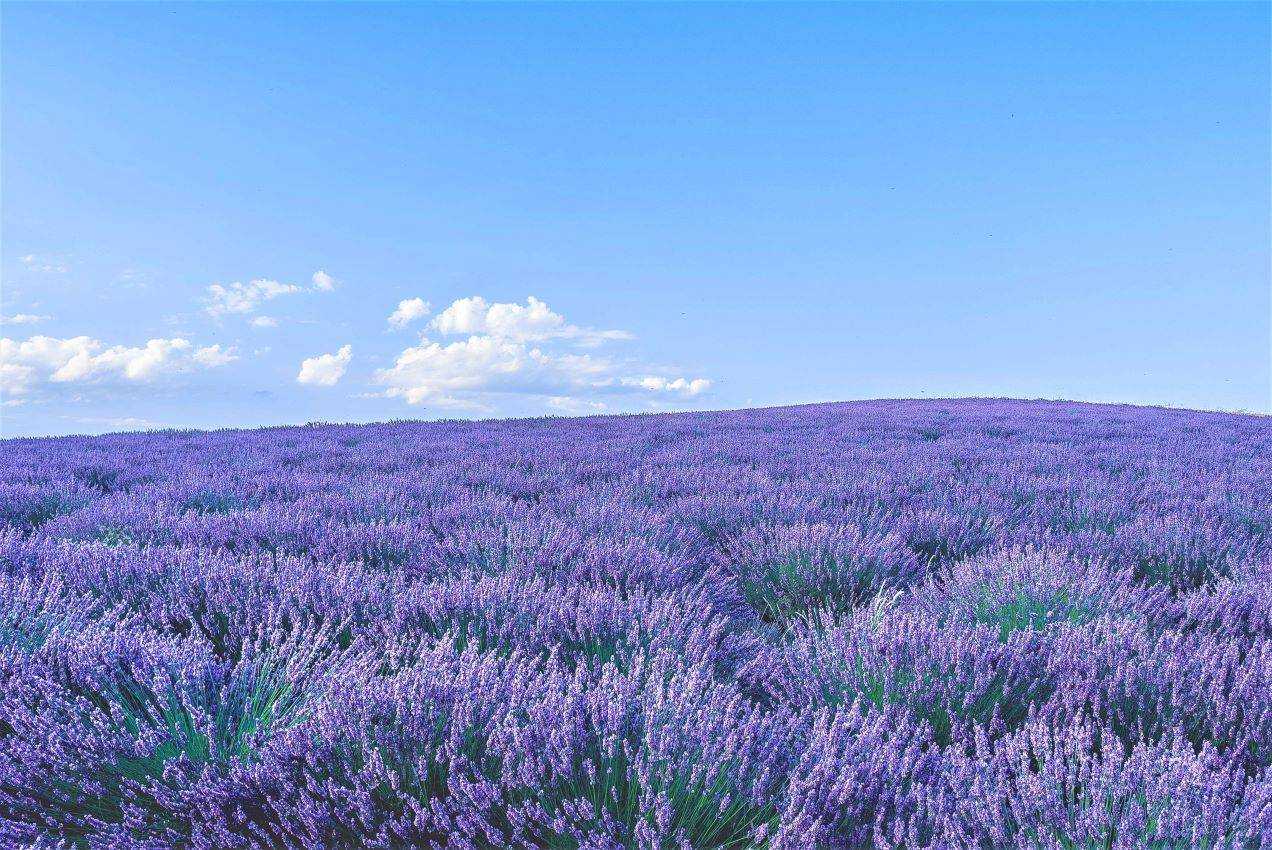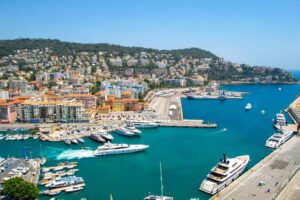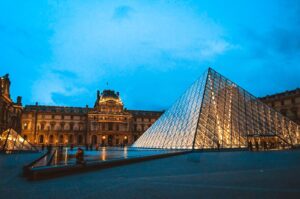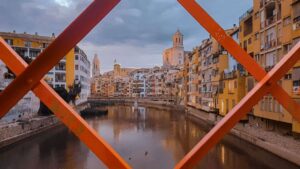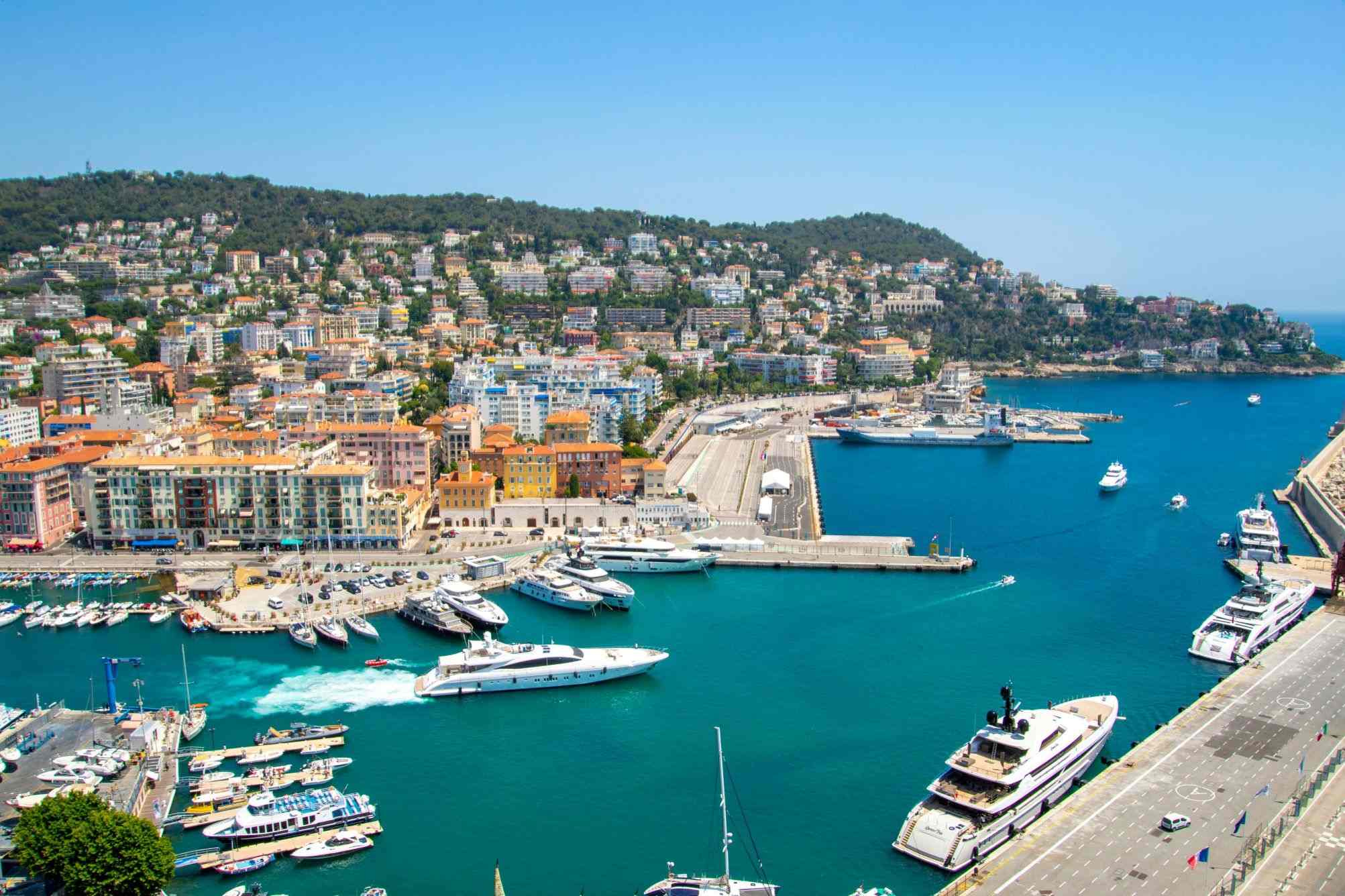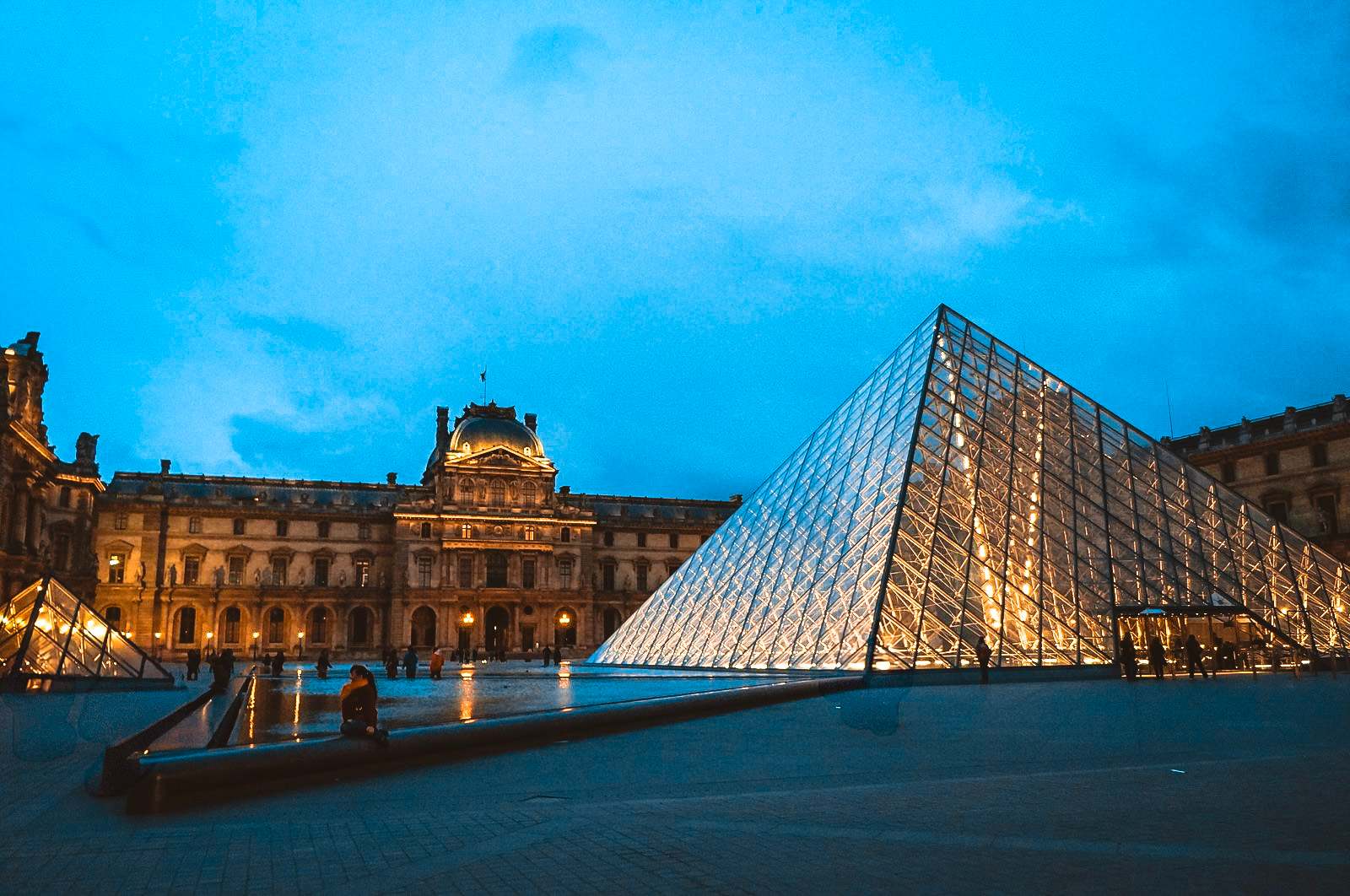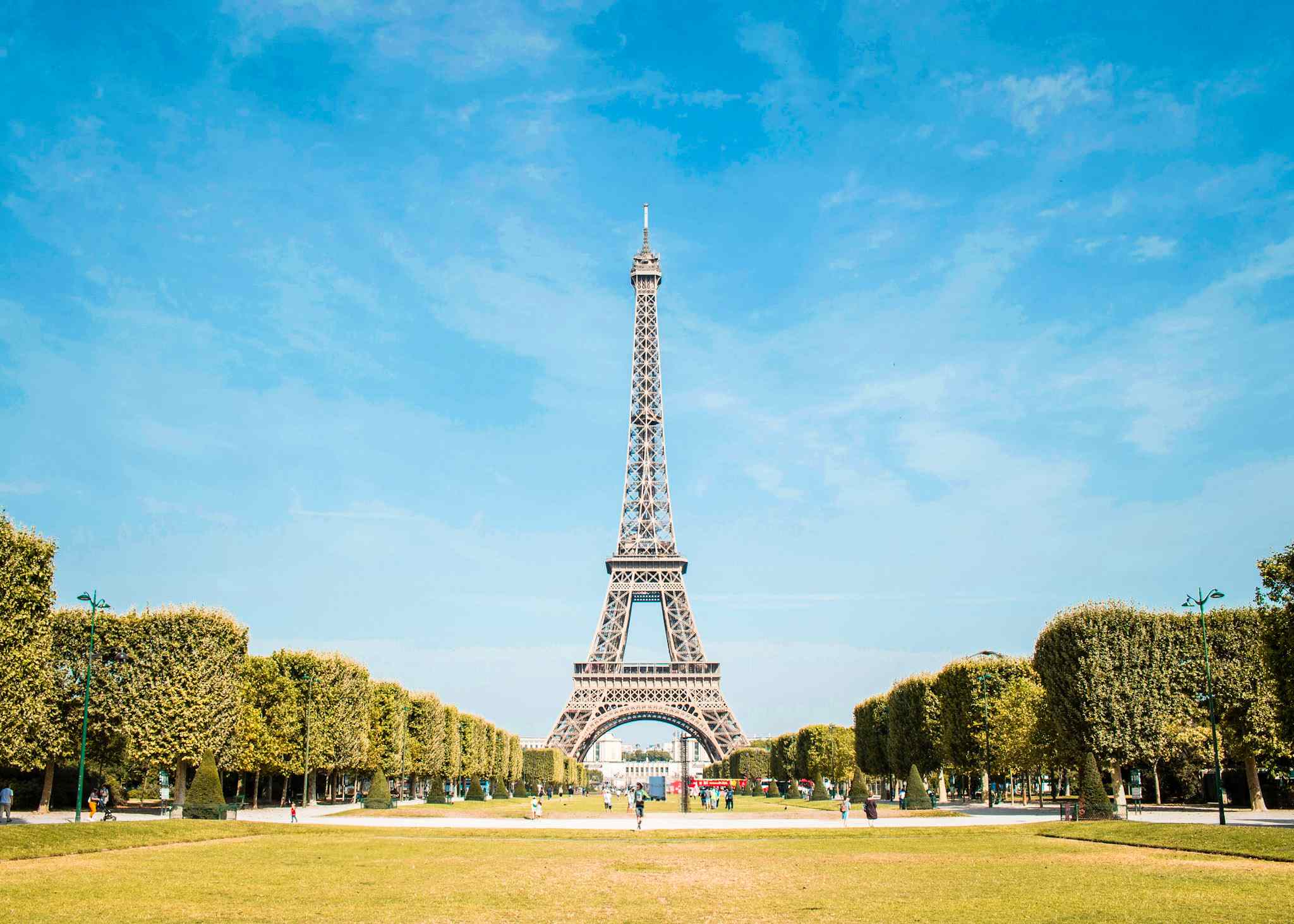South of France Road Trip: The Ultimate Two-Week Itinerary
This South of France road trip itinerary is the perfect French holiday for those looking for beautiful beaches, adorable little villages, stunning coastal views, and delicious food. The climate in this area of France is wonderful with long summer days that stretch through to September and October. Winters in Southern France, especially along the Mediterranean coast, are always mild.
If this is your first time in the region, this South of France road trip itinerary will be perfect for you. It takes you through smaller towns, seaside retreats, lush vineyards, larger cities, and the beautiful lavender fields in Provence. You can use some of the larger cities as a base while exploring the smaller towns and villages. You can mix things around in this itinerary if you want to.
There are so many places to visit in this region and of course, time is always of the essence when you are exploring new places.
We’ve put in a lot of thought into what worked best after our experience traveling through the region to bring you this is the ultimate South of France road trip itinerary. These are our tips to make the most of what these regions offer and are meant as a guide to help your Southern France road trip planning.
We’ve broken this down into various regions and included some villages/ towns that you can visit along the way. We have no doubt you’ll find places that you will want to visit more than others or you may even try to cram in as much as you can in your two weeks there! This itinerary for two weeks in the South of France is a great trip to do for families traveling with kids.
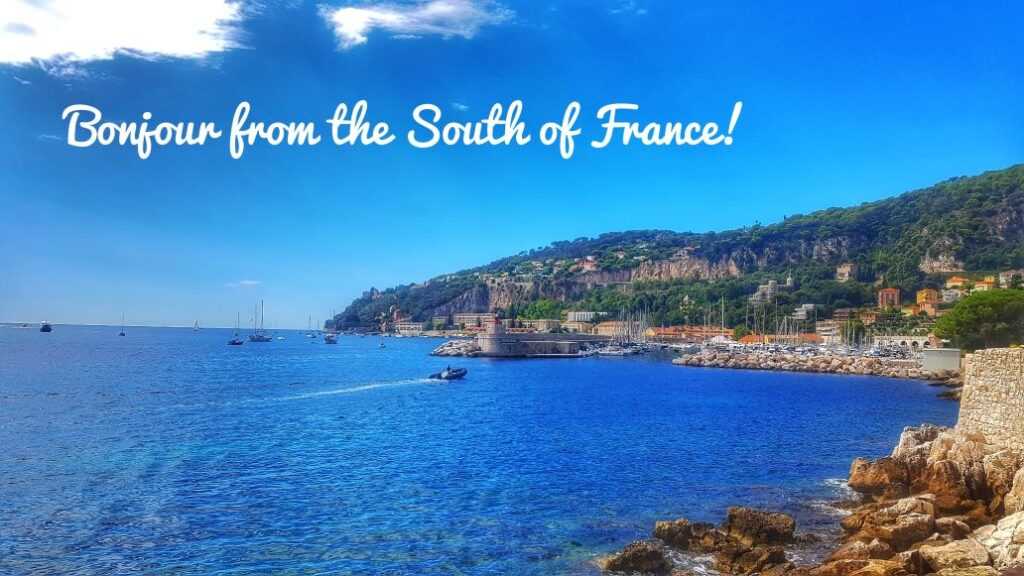
** Disclaimer: Please note some of the links in this post are affiliate links. Purchasing through these links earns us a small commission at no extra charge to you.
Table of Contents
ToggleSouth of France road trip overview
- Start: Nice
- Suggested route: Nice ⇒ Monaco ⇒ Cannes ⇒ Aix-en-Provence ⇒ Avignon ⇒ Montpellier ⇒Toulouse ⇒ Bordeaux
- Finish: Bordeaux
- Duration: 14 days
- Regions covered: Côte d’Azur, Provence-Alpes, Occitanie
- Best for: History, sightseeing, nature, small towns, food
- Day 1: Nice (4 nights)
- Day 2: Nice
- Day 3: Monaco
- Day 4: Cannes
- Day 5: Aix-en-Provence (1 night)
- Day 6: Villages in Provence ⇒ Avignon (2 nights)
- Day 7: Avignon
- Day 8: Pont du Guard ⇒ Uzès ⇒ Nîmes
- Day 9: Montpellier (2 nights)
- Day 10: Sète
- Day 11: Montpellier ⇒ Carcasonne ⇒ Toulouse (2 nights)
- Day 12: Toulouse
- Day 13: Bordeaux (2 nights)
- Day 14: Bordeaux
Starting Point for your South of France road trip itinerary
This South of France road trip starts in Nice and ends in Bordeaux. The itinerary covers some of the best places to visit in the South of France. Nice is easy to reach by train from Paris or Milan or another country.
You can of course change things around and start in Toulouse or Bordeaux and finish in Nice if you want to. It all depends on where you are flying in from and what your budget is. Nice, Toulouse, and Bordeaux all have significant airports in France.
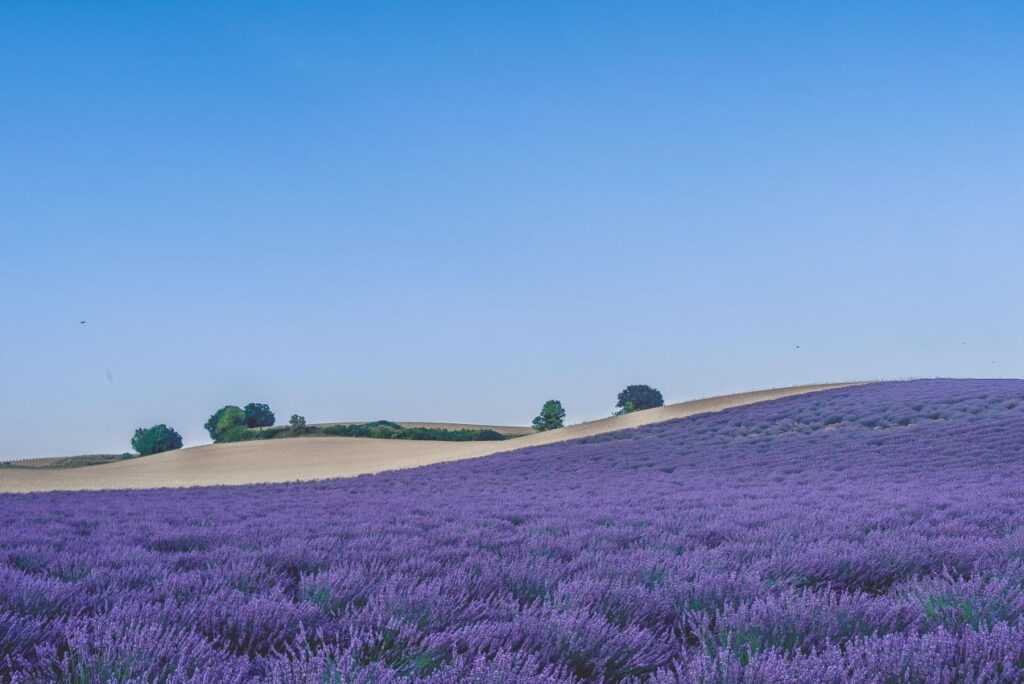
What’s included in this South of France road trip Itinerary
The South of France is so much more than the glitzy towns of Nice or Saint–Tropez. It’s broken into many different regions that consist of everything from seaside towns, and medieval countryside villages to some of the South of France’s less touristy cities like Montpellier.
South of France comprises of several regions that are covered in this two-week itinerary: The Cote D’Azur (also known as The French Riviera), Provence, Occitanie, and Bordeaux.
Côte d’Azur (a.k.a The French Riviera): The Côte d’Azur or French Riviera is filled with glitz and glamour and includes some popular places such as Nice, Cannes, Monaco, and Saint Tropez.
Provence: Provence is one of the most visited areas in the South of France. The lush countryside bursts with charm and history. You’ll find plenty of medieval hilltop towns, beautiful laver fields, and several open-air markets. Areas covered in this region are Aix-en-Provence, Lourmarin, Roussillon, Gordes, Uzes, and Avignon.
Occitanie: This region is the southernmost region in France and includes two large cities, Toulouse and Montpellier. Occitanie’s Mediterranean shoreline, mountain ranges, and historical and cultural identity make it a popular tourist destination in France.
Bordeaux Region: Bordeaux is so much more than a city in France. It’s an entire region known for its wine production. Being able to visit and see firsthand how the process takes place and sampling the wine, is one of the best things you will do. And if you don’t drink wine, there’s still plenty this region has to offer.
Wherever you base yourself, there will always be a myriad of villages and towns close by. So don’t feel like you have to do it all. Just pick the places that appeal to you and enjoy them while you are there.
South of France Road Trip: The Ultimate Two-Week Itinerary
The South of France invokes many different images; for some, it’s the food, for others, it’s a glamorous getaway in the French Riviera or a visit through some of the hidden treasures. With so many great places to visit, beautiful scenery, food, and culture that is hard to beat; the South of France is a region where there’s truly something for everyone.
In this itinerary, we’ll cover the most beautiful French cities, medieval towns, and natural wonders, and end off in the lush regions of the wine country.
The first stop on this incredible adventure is Nice. We based ourselves in Nice for a few days and used this time to explore the Cote d’Azur. Our check-in for our AirBnb wasn’t till later that afternoon. So, we used the time to drive around the area to get a feel for things.
Day 1: Arrive in Nice, explore Nice and Villefranche–sur–Mer
Nice is known for its beautiful waterfront promenade, lush gardens, and beautiful beaches. Arrive at Nice in the morning if you can or the day before you start your South of France road trip. You’ll spend 4 nights here exploring the Cote d’Azur.
On arrival in Nice, we picked up our leased car and went to the neighboring town, Villefranche-sur-Mer. What a dream this little seaside town was! It is a hidden gem in the French Riviera!
Take a stroll through the Old Town and spend a few hours getting lost in the narrow cobbled streets. At the foot of the Old Town is the Romanesque Saint-Pierre Chapel. This chapel is small but worth the visit. The best thing to do in Villefranche is to walk around town and spend some time relaxing by the water. We grabbed some lunch and did exactly that.
Later in the afternoon make your way back to Nice and check into your accommodation if you haven’t already. Our little Airbnb was the cutest little place that offered great views of the sea.
Exploring Nice
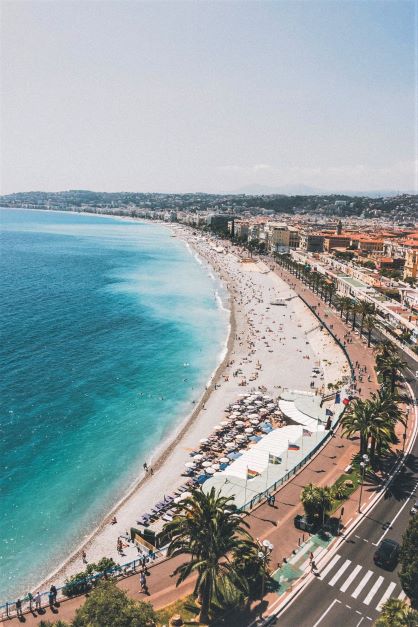
Walk through the narrow streets of Promenade des Anglais to soak up the sights of the gorgeously blue Mediterranean Sea. You never tire of strolling along this famous avenue which runs along the coast for 8 kilometers. The city is beautiful and displays traces of many different styles.
Find a cute restaurant by the beach along the way and grab an early dinner. Alternatively, grab some food from the supermarket and have a picnic at the beach. Either way, soak up the atmosphere along the French Riviera, you’ll be in for a treat.
We happened to be in Nice on Assumption Day and witnessed a huge firework display that evening which we thoroughly enjoyed. It does get pretty crowded so if you aren’t a fan of the crowds, find a spot in the distance and enjoy the fireworks display.
Day 2: Explore Nice
Today you’ll continue exploring Nice. The city is known for its glittering Mediterranean beaches, picturesque Old Town, and its century-old promenade. You can spend 2 to 3 days discovering Nice. There’s something irrevocably special about the city.
Things to do in Nice
- Go for a scenic walk along Promenade des Anglais
- Explore the Vieille Ville (Old Town) on foot
- Marvel at the Musée Matisse
- Visit the gorgeous Dome of the Nice Cathedral
- Buy colorful fresh flowers in the Cours Saleya Market
- Sample the famous Niçoise Salad
- Experience the colorful Nice Carnival
- Discover the idyllic French Riviera beaches
- Take day trips to neighboring cities or towns
Day 3: Monaco

Start day 3 nice and early. You’ll want to head to the train station to catch one of the first few trains to Monaco. You only have a day in Monaco, so you’ll want to check out the best things to do in Monaco to make the most of your time there.
This independent city-state on the French Riviera is known for its yacht-lined harbor, upscale casino, and prestigious Grand Prix. Monaco is the perfect day trip from Nice. It’s about a 30-minute train journey and slightly longer on the bus.
You’ll be wondering why we’ve suggested catching a train when you’ve probably hired a car for your duration in the South of France. We recommend against driving to Monaco. It’s a busy place, parking can be hard to find and expensive. Whereas a bus or train ride is very affordable and most of Monaco is easily walkable. We provide more detail in our Monaco guide.
You’ll spend most of day 3 sightseeing in Monaco. The key to exploring Monaco is to see the things that make it special – the glamour and the opulence. But also to go a little deeper to discover its heritage and local life. You’ll find the best things to do in Monaco are a mix of all of these.
Things to do in Monaco
- Stroll through Old Town
- Visit Palais du Prince (The Prince’s Palace)
- Marvel at the Monaco Cathedral
- Visit Oceanographic Museum
- Take in beautiful views at Port de Fontvieille Viewpoint
- Wander around Jardin Exotique
- Explore Monaco Harbour
- Take a walk along the Formula One Track
- Take a few photos at the Casino Square
- Visit the famous Monte Carlo Casino
- Coffee at Cafe de Paris
- Monte Carlo neighborhood
- Visit the Japanese Gardens
- Watch a race at the Formula One Monaco Grand Prix
On your return to Nice, you could head back to Promenade des Anglais for some dinner. Alternatively, grab some food and take it back to your apartment or hotel and have a relaxing evening. We choose to stay in and enjoy the views from our balcony.
Day 4: Cannes
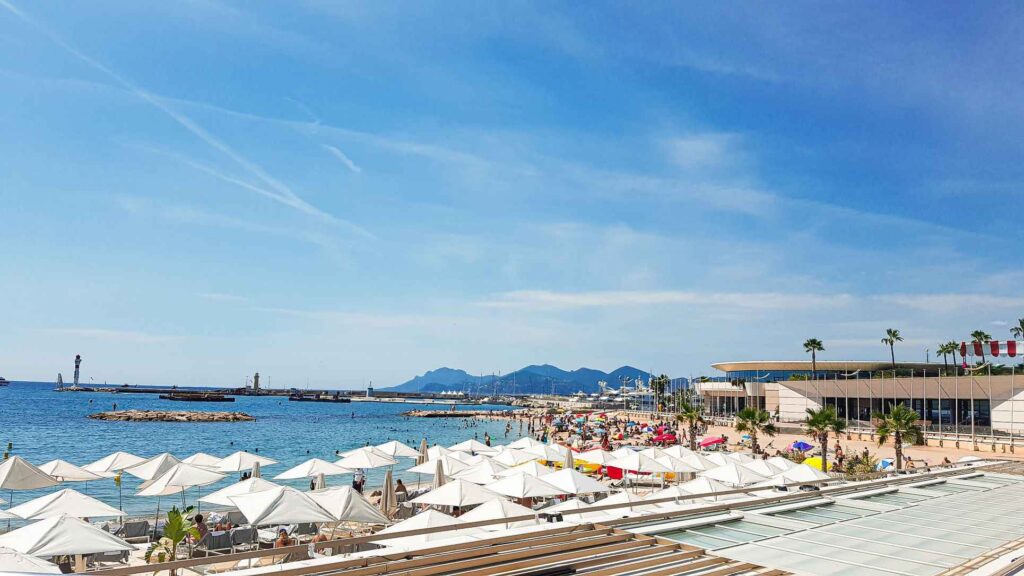
You’ll drive to Cannes from Nice this morning (you can also take a train if you prefer). There are plenty of parking garages so check ahead so you know exactly where to head to when you get to the city.
Cannes is your last stop on the French Riviera. Known for its luxurious accommodations, private beach clubs, and high-end shopping, as well as the world-famous Cannes Film Festival, Cannes truly is a dream destination for many travelers. You’ll find the rich and famous spending their free time in this city. Cannes is the kind of place you visit when you want to relax and enjoy some luxury.
Things to do in Cannes
- Explore Le Suquet (the Old Town)
- La Croix des Gardes neighborhood
- Take a photo on the famous Red Carpet
- Find the walk of stars
- The Old Port
- Take a stroll down Boulevard de La Croisette
- Unwind on the beautiful sandy beaches
- Have a drink at one of the luxury hotels
- Climb up to the castle
Other destinations in the French Riviera include Saint-Tropez which is where you’ll find the rich and famous holidaying. The French Riviera also has smaller lesser-known towns that are full of charm; Antibes, Roquebrune-Cap-Martin, and Menton.
However, with this two-week Southern France itinerary, we chose to visit a few of the places to allow us more time to explore the rest of South France.
Day 5: Aix – en – Provence
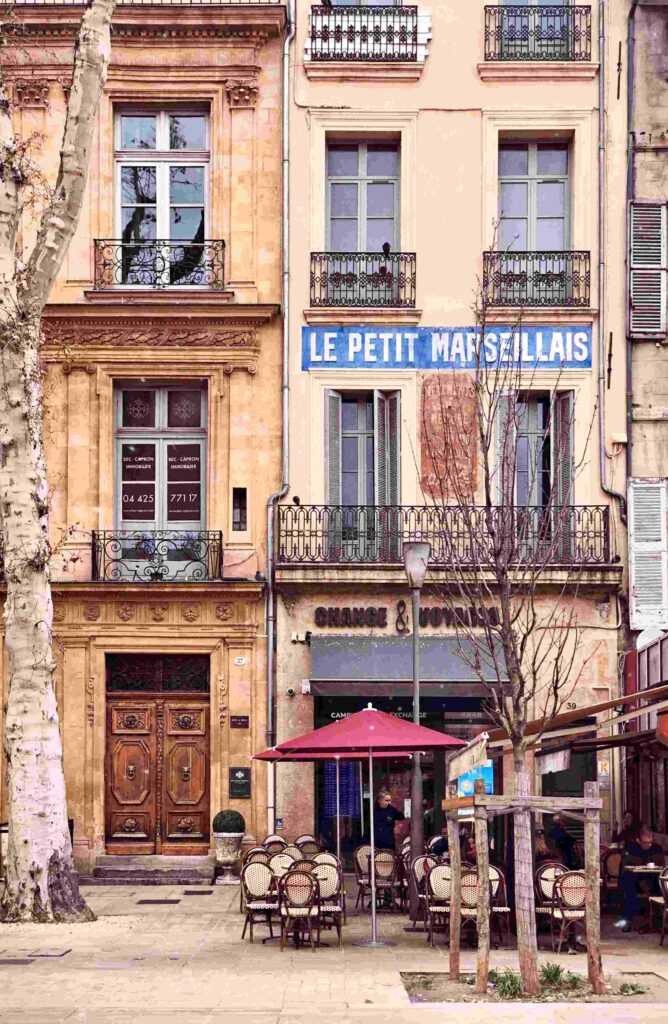
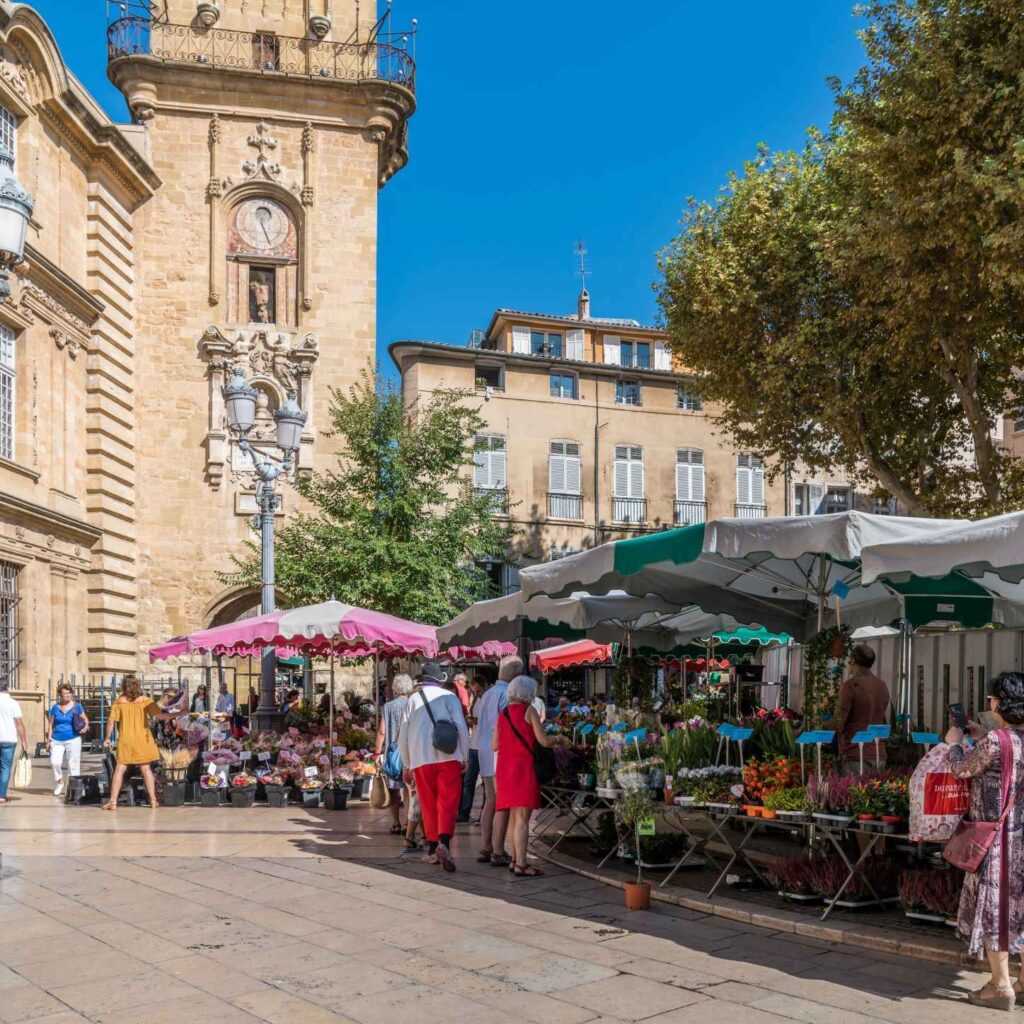
From Cannes, you’ll make your way to Aix-en-Provence, a typical Provencal city in Southern France. The drive from Cannes to Aix is about 1 hr 45 mins.
Aix’s historic center boasts beautiful architecture, and artistic heritage inspired by the greatest and pretty squares adorned with stone fountains. The markets of Aix are also worth exploring alongside the historical monuments. Aix-en-Provence exudes an undeniable charm, you have to walk through its streets and squares to experience it. You’ll spend a night here which will give you a chance to relax before you start the next leg of this Southern France road trip.
The old center of Aix is small enough to explore on foot. The main center of Aix is lined with cafes, restaurants, and plenty of places to relax and enjoy the sun.
Things to do in Aix–en–Provence
- Take a walk through the city center and Old Aix
- Visit Cathedral de Aix-en-Provence
- Explore the Mazarin neighborhood
- Taste the famous calissons (a mix of almonds and candied melon with orange blossom fragrance, marzipan is a sun trap all by itself. This is the specialty of Aix-en-Provence)
- Head to Granet Museum (art museum)
- Take a walk through the gardens at Hotel de Caumont
- Visit Montagne Sainte-Victoire (if you feel up to a hike)
Market days in Aix-en-Provence are Tuesday, Thursday, and Saturday. You can find local products, antiques, and local crafts.
Marseille is about a 30-minute drive from Aix. So if you are feeling up to it in the evening, you can head to Marseille for great shopping and a delicious meal. It’s a city worth exploring, however, with only 2 weeks in this itinerary, you’ll have to pick and choose what places you want to visit.
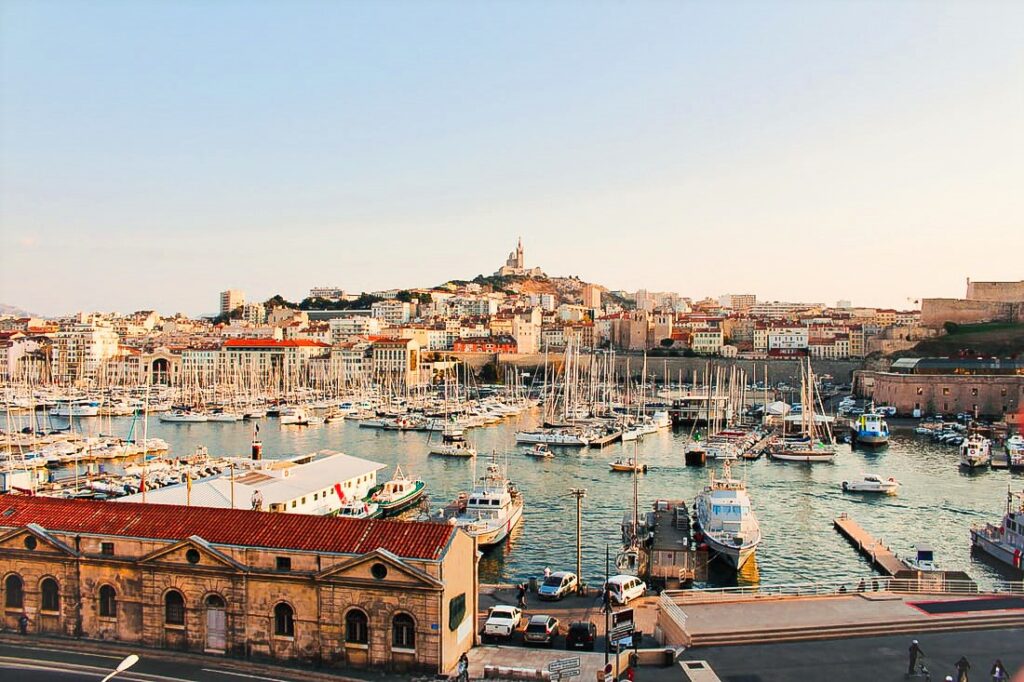
Attractions in Marseille
- Notre-Dame de la Garde
- Vieux Port
- Château d’If
- Cathédral de La Major
- MuCEM – Museum of Europe and Mediterranean Civilizations
- La Panier – the oldest district
Day 6: Explore small villages in Provence ⇒ Avignon
You’ll depart Aix-en-Provence nice and early to make your way to Avignon. You’ll spend 2 nights in this city exploring the region.
Avignon makes a good base to cover some of the best spots in Provence. This tour covers the charming hilltop villages of the Luberon, Gordes, and Roussillon.
If you are driving yourself, on your way to Avignon, you will explore the Luberon region including the beautiful villages of Provence such as Lourmarin, Roussillon, and Gordes. These villages will see you come across local farmers’ markets, beautiful streets lined with olive trees, and incredible lavender scents.
- Aix-en-Provence – Lourmarin – 40 mins
- Lourmarin – Roussillon – 35 mins
- Roussillon – Gordes – 18 mins
The Luberon Valley is known for its beauty and is a must-visit on any Provence itinerary. With beautiful hilltop villages and rolling countryside filled with lavender fields, this part of your Southern France road trip will blow your minds as it did ours.
A visit to the Luberon is to walk through the narrow streets of the perfectly perched villages such as Gordes or Lourmarin, to hike in the Ochres de Roussillon, or discover the local Provençal markets.
Lourmarin
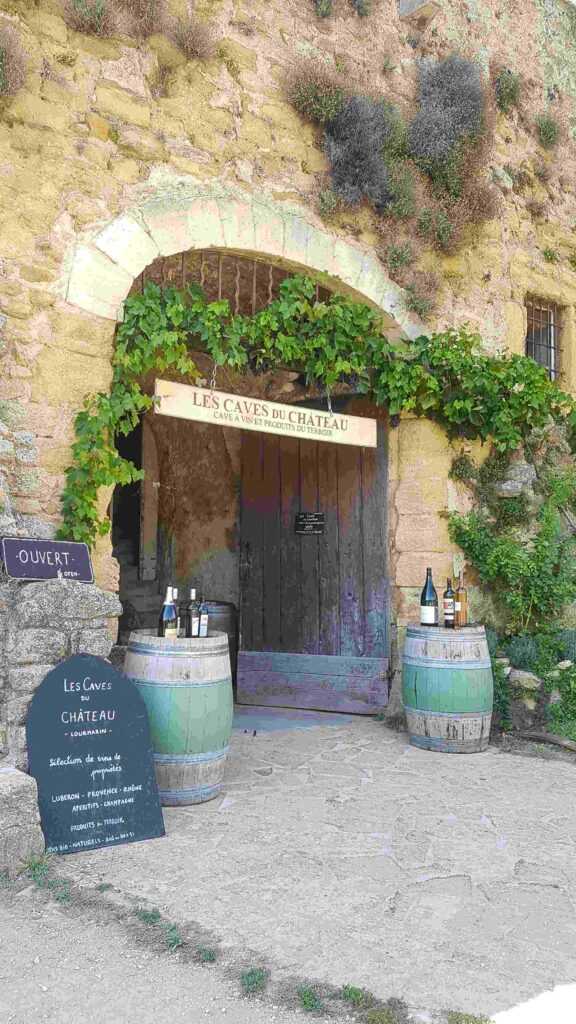
Nestled in the heart of vineyards, the village of Lourmarin is one of Southern France’s most beautiful villages and offers picturesque scenery, historical attractions, and delicious local cuisine. Take a walk through its narrow cobblestone streets and grab a coffee at one of the quaint cafes, it’s the perfect escape from the hustle of the city.
The walk through the village is an absolute delight. You can explore the village’s beautiful chateau, stroll through its lush vineyards, and indulge in the local cuisine.
Don’t miss the bell tower that houses the village clock. It was built in the 17th century.
Roussillon
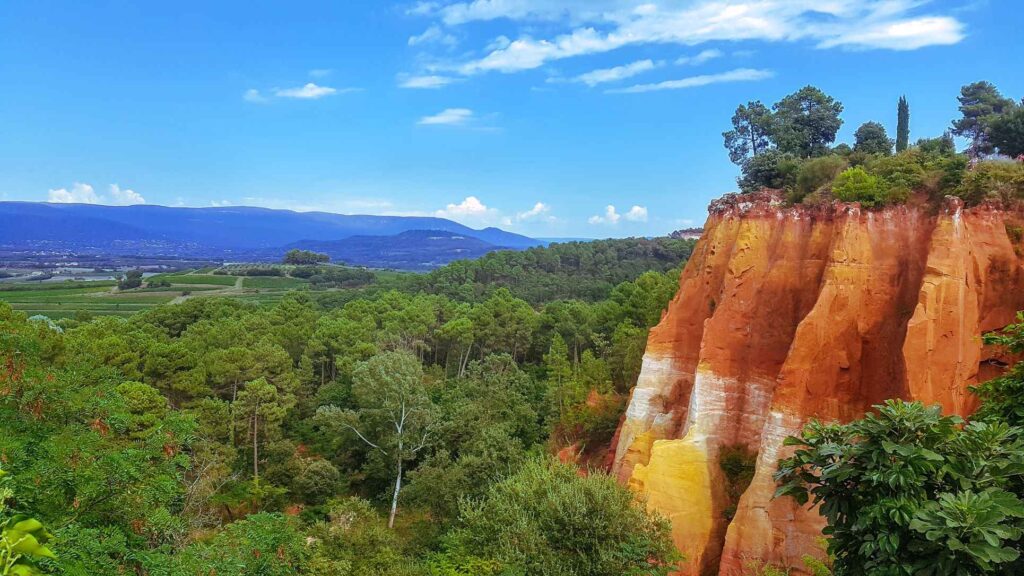
Roussillon is another small village that sits at the foot of the Vaucluse mountains. It’s filled with cafes, galleries, and markets. It is famous for its colorful houses and its ocher quarries and its uniqueness comes from the orange-yellow–red cliffs. This along with the lush green vegetation and blue sky makes Roussillon magical.
Plan to spend a couple of hours here to explore the town and walk the ochre trail that goes through the natural red quarries and cliffs. The town is full of old red buildings with colorful doors. It’s a must-see on a road trip through the Provence region
Be sure to climb to the very top of the village where you’ll get incredible views of the Vaucluse mountains and Mont Ventoux. There is also a museum, Ôkhra, the Ocher eco-museum, which offers a very interesting experience. You can take a guided tour to learn all about ochres and colors, from prehistory to the present day.
Senanque Abbey
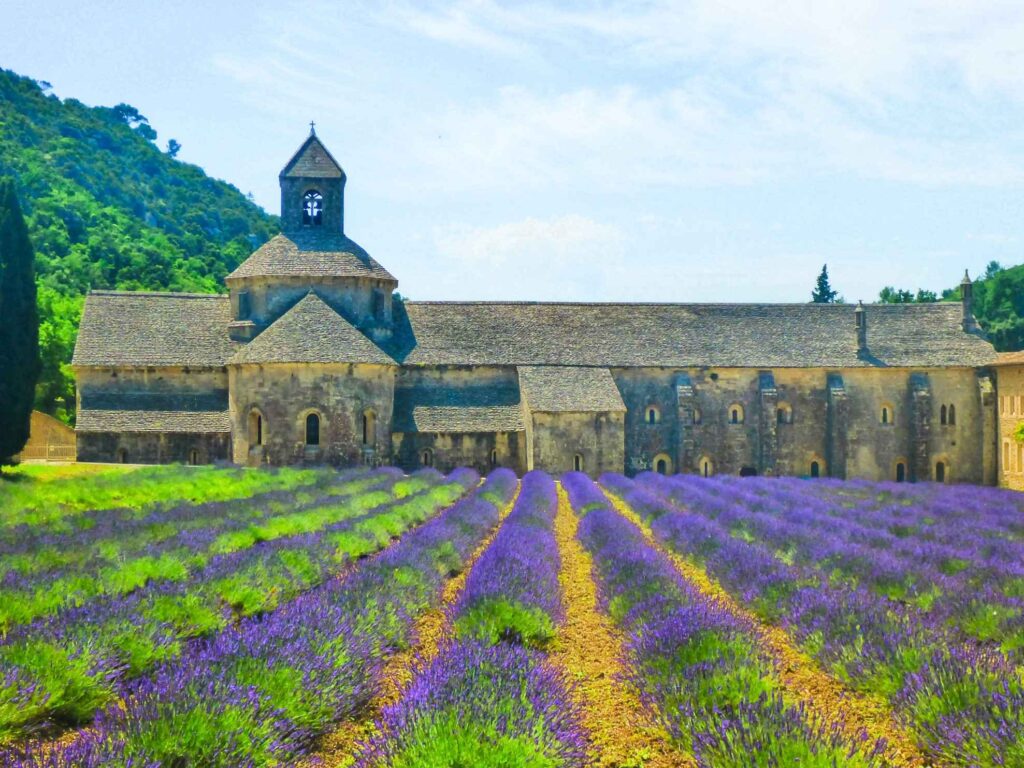
Before you make your way to Gordes, take a slight detour and head to Abbey Senaque, a sight in Provence you definitely don’t want to miss. It’s a fully functioning monastery that was founded in the 12th century and is one of the most picturesque sights you will come across in this region. They have guided tours that start every hour, and it’s one of the best ways to soak in all of the information.
They also have a little shop where you can buy some amazing lavender products and delicious fig jam.
Gordes
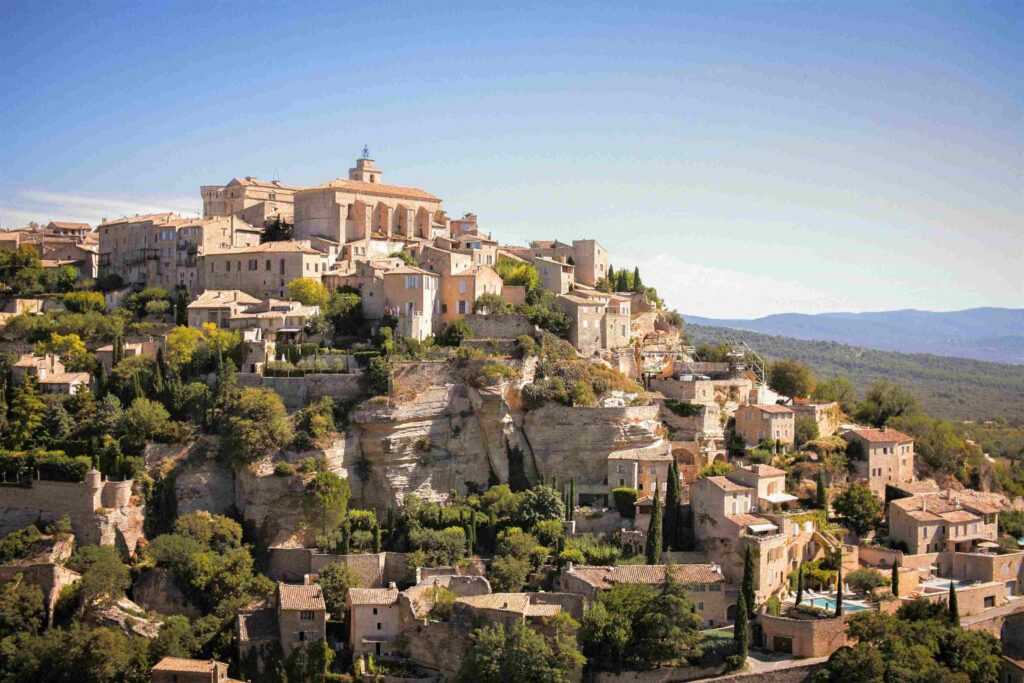
You’ll finally finish off with this region in beautiful Gordes, a Provençal village perched up on a hilltop. Gordes is one of the most well-known hillside villages in Provence. Tourists flock to this region to take in the incredible views and atmosphere of the village. Its charm has a way of captivating everyone who visits.
Take a walk through the cobbled streets and discover the cute houses, dry stone walls, fountains, and an incredible panoramic view. In the center of Gordes, you’ll find a 10th-century castle that houses the town hall. Don’t forget to stop by Saint Firmin church, built in the 18th century.
They have a weekly farmers market that runs on Tuesdays, so if you happen to be here on this day be sure to take a walk through the market. You can find some great local delicacies here.
You can finish your time off in this region by grabbing dinner at one of the local spots in Gordes. Then make your way to Avignon where you’ll spend the next 2 nights.
Depending on when you get into Avignon, settle into your accommodation and get a first glimpse of the city. You can make your way into town and visit the impressive Papal Palace. Avignon was once the home of popes so this place is not one to miss off the itinerary.
Day 7: Avignon
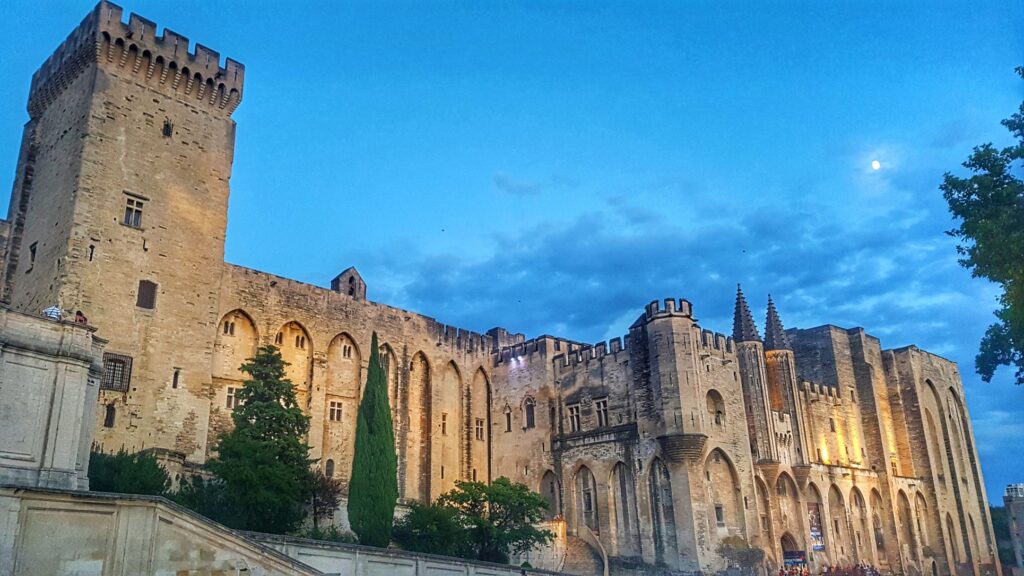
Today is all about exploring the city of Avignon. Avignon is a historic city best known for being the location the Popes fled to after leaving Rome in the 14th century. This led to the construction of the incredible Palais des Papes – one of the city’s most famous attractions. Its old town is a UNESCO World Heritage Site and as you walk through its ancient streets, you will quickly understand why! Staying here will make you feel like you are transported back in time.
The city is a popular base for exploring the wider Provence region. It has its own attractions that has a way of charming people over. In the center, you’ll find restaurants and cafes where you can stop for a well-deserved break. The streets of Avignon are filled with history and music bustling the inner-city walls.
The Notre-Dame-des-Doms cathedral, built in the 12th century, is famous for its bell tower at the top of which sits a golden Virgin. The stained glass windows and frescoes are sumptuous! On leaving the cathedral, be sure to cool off in Jardin des Doms (Dom’s garden’). A real haven of peace!
Here are some of the top things to do in Avignon:
- Marvel at Palais des Papes (Pope’s Palace)
- Place du Palais
- Take a stroll along Pont Saint -Bénézet
- Basilique Saint-Pierre d’Avignon
- Place de l’Horloge
- Rue des Teinturiers
- Avignon Les Halles
- Take a cruise along the Rhone
- Visit the city’s museums
While you’re in Avignon, you’ll want to visit the Pont Du Gard. The 2,000-year-old Pont du Gard aqueduct is incredibly impressive and only a 30-minute drive from Avignon. You’ll do this tomorrow after a good night’s rest.
Day 8: Pont du Guard ⇒ Uzès ⇒ Nîmes
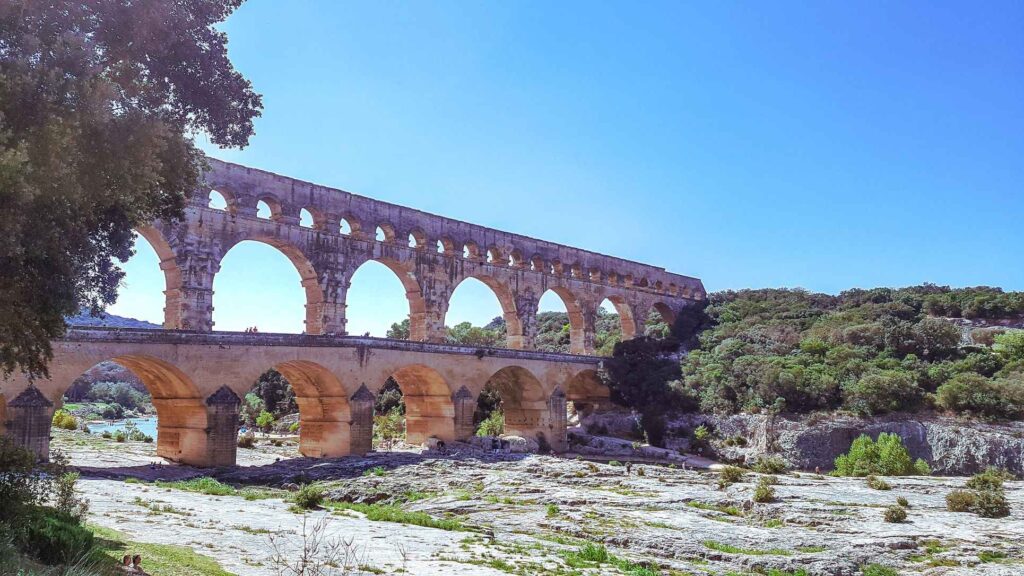
Make your way to Pont du Guard from Avignon. You’ll want to get there when it opens to ensure you get a good parking spot and avoid larger crowds that make their way through the day.
The aqueduct is a UNESCO World Heritage site and one of the best-preserved Roman buildings. Pont du Guard is the most visited ancient monument in France and remains one of humankind’s greatest masterpieces. You have to see it for yourself to understand the magnitude of this structure.
It is 48 metres high and has three vertical rows of arches: 6 on the lowest level, 11 on the second level, and 35 on the third and top level. It served as an aqueduct until the 6th century before becoming a tollgate in the Middle Ages and finally a road bridge from the 18th to 20th century.
The admissions ticket to the site allows entry to the facilities situated on the two banks of the Gardon:
- The Museum of the Pont du Gard, where you can learn about the history of the aqueduct’s construction
- A small cinema showcasing the site
- An outdoor exhibition about human occupation here since 2000 years ago
- Ludo is an entertaining and educational space for children
- Temporary artistic and scientific exhibitions
- A restaurant-cafeteria on both sides of the river
Pack a swimsuit and a picnic to take with you. When you first get there, you can walk around and cross the bridge. Find a spot where you can set up your picnic and enjoy a swim. You can also kayak under the bridge if you are feeling up to it.
It’s a fascinating historic site and one that you shouldn’t miss if you are traveling through this region.
Uzès
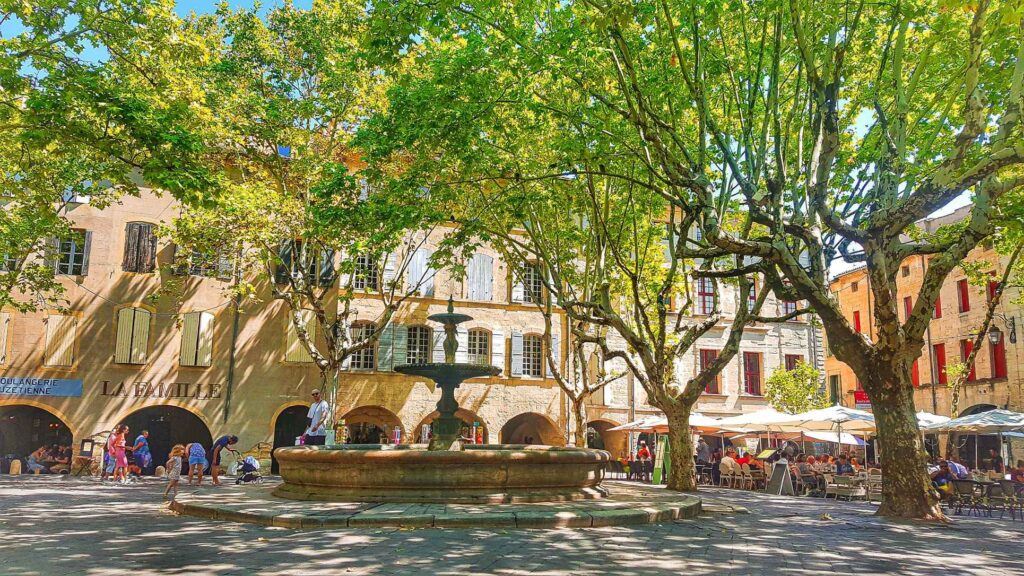
After lunch head back on the road and make your way to Uzès which is about 20 minutes from Pont du Guard.
Known for its Middle Ages Bell Tower and picture-perfect market square, Uzès is a place you must explore for a couple of hours. You can pick up a map at the tourist office which will give you a walking route of the town. Like most small French towns, you cannot drive through the town.
Walk through the cobblestone streets, pop into a café, and grab some delicious pastries. Indulge as you walk through the town center. We found a shady tree in the central square of Place aux Herbes and sat there while we enjoyed our croissants and macaroons. La Fougasse d’Uzès has some delicious French pastry. We went back for more!
Be sure to visit the Uzè Cathedral as you make your way through the town.
Nîmes
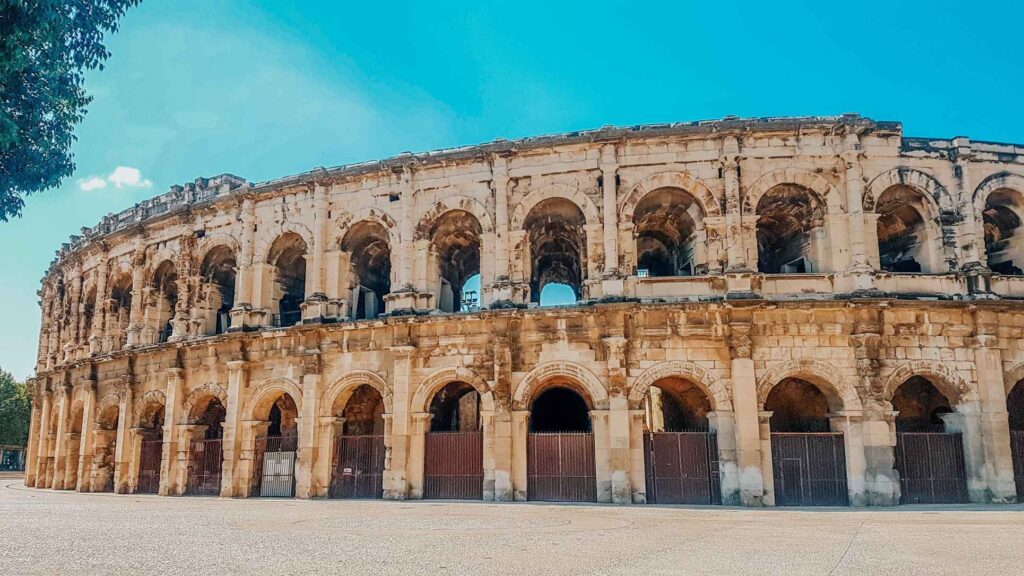
Your last stop for the day in the Occitanie region is Nîmes, a 30-minute drive from Uzès. Visiting Nîmes will be like stepping back in time. Nîmes is home to several well-preserved architectural marvels from the Roman Empire, the most important one being the Arène de Nîmes (the Roman Arena), which is still used for concerts and events.
Stop by to get some gelato and snacks before you walk through the scenic 18th-century garden, Jardins de la Fontaine. Grab a seat under a tree and enjoy some quiet time here.
Other notable attractions in Nîmes include:
- Amphitheatre of Nîmes
- Nîmes Old Town and Place du Marché
- Maison Carrée
- Temple de Diane
- Carré d’Art
- La Tour Magne
- Jardin de la Fontaine
You can grab some dinner in Nîmes or head back to the town center in Avignon and finish your night off there.
Day 9: Montpellier
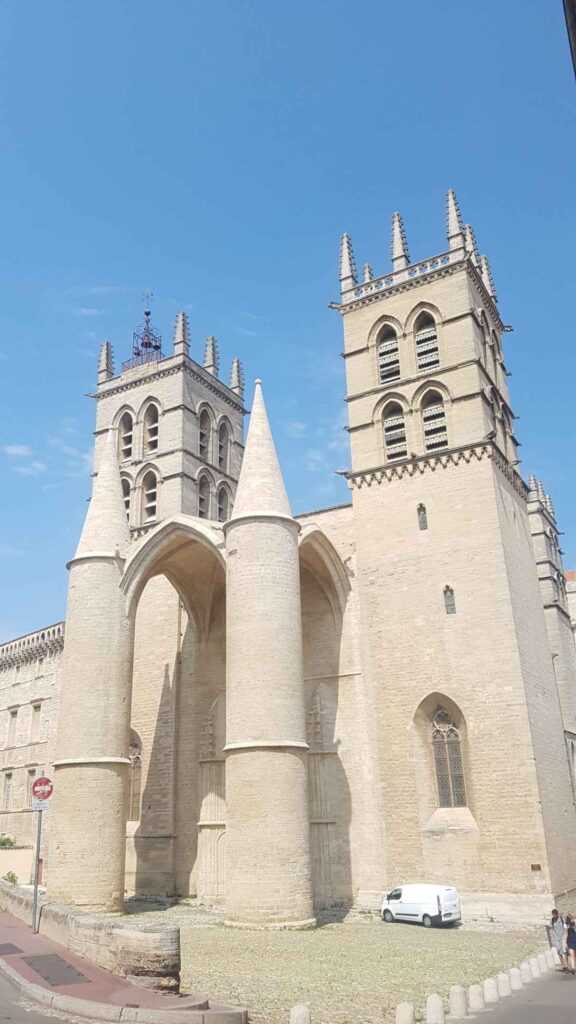
On day 9, you’ll make your way to Montpellier. It’s about a 90-minute drive from Avignon.
Montpellier is one of the larger cities in France but sneaks under the mass tourism radar. Most of the main attractions in Montpellier can be found in the rather condensed historic city center.
The city is best explored on foot. Make your way through the cobbled streets and discover historic monuments, museums, churches, and art galleries, or stop by one of the cafes for a bit of a break from all the sightseeing.
The weather here is incredible boasting 300 sunny days a year. So, you should have no problems exploring the city on foot.
Some of the best places to visit in Montpellier are as follows:
- Promenade du Peyrou
- Place de la Comédie
- L’Écusson (Old Montpellier)
- Cathédrale Saint-Pierre
- Quartier Saint-Roch
- Palais des Congrès de France
You’ll spend 2 nights in Montpellier to give you a bit of a breather from the fast-paced itinerary.
Day 10: Sète
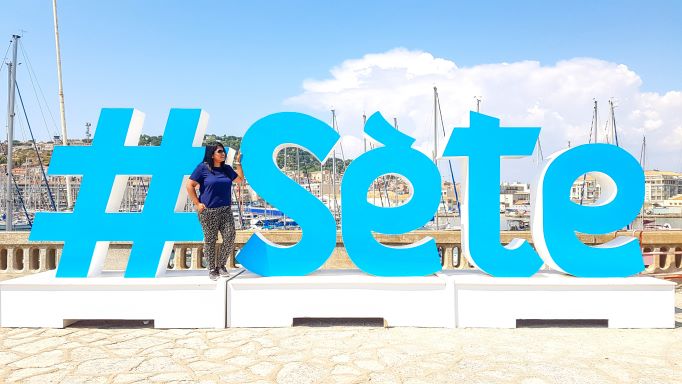
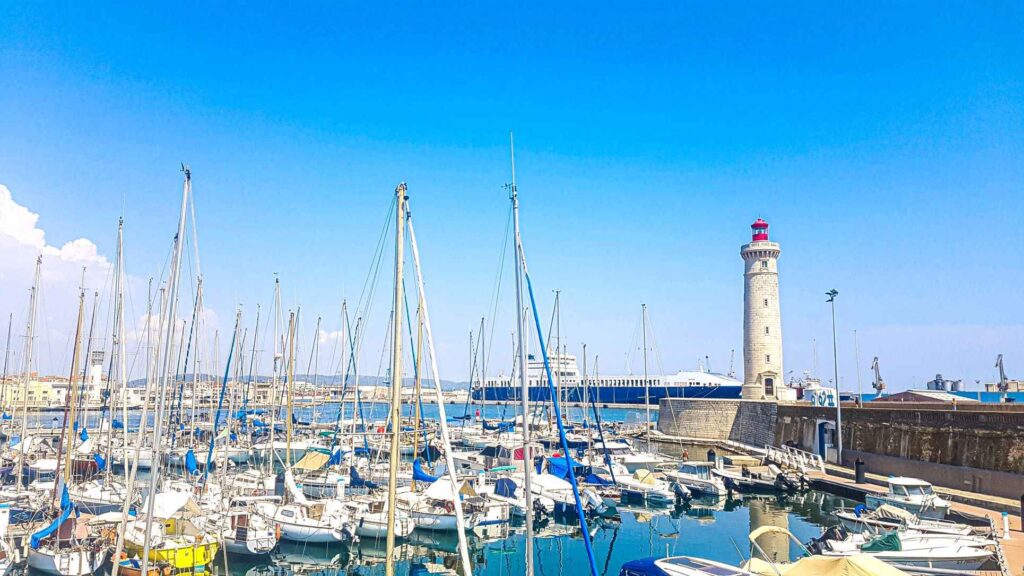
Sète wasn’t even a town we had heard of prior to visiting the South of France. It was when we got to the country, that our friend who is a local, suggested we make a day trip to this cute town. It’s only 45 minutes from Montpellier. If you are driving, there are a few car parks around the city, but these can get quite busy. So just be mindful of this when visiting.
Sète is etched with waterways and boasts a beautiful old port. The town falls into two parts, the low and high town. The port, canals, and bridges cover the low town, while the high town covers Mont St Clair.
It is referred to by the locals as the Venice of Languedoc. The town lies at the foot of Mont St. Clair, 175 meters above sea level. You get spectacular views of the town from the top of Mt St. Clair. You can hike, drive or catch the bus to the top.
Every year Sète hosts the ‘Joutes de Sète’ a jousting tournament from boats. The competition takes place from the end of June to the beginning of September. So if you are around this time of the year, try and plan your visit to the town during this time.
If you are short on time, take a ‘little train’ guided tour to see the highlights of Sète.
Top attractions in Sète include:
- Sète Old Port
- Cimetière Marin
- Water Jousting
- Saint-Louis Lighthouse
- Mont Saint-Clair
- Notre-Dame-de-la-Salette
- Musée Paul Valéry
- Petit Train
- Delicious Gastronomy
Day 11: Montpellier ⇒ Carcasonne ⇒ Toulouse
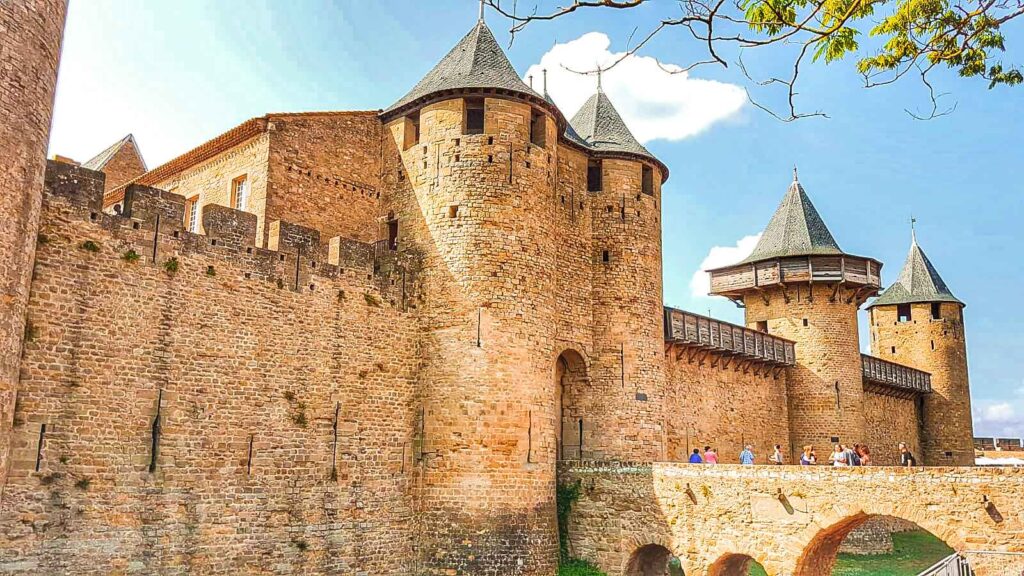
On departing Montpellier, you’ll make your way to Toulouse. But before, you’ll explore a charming medieval town on the way called Carcassone.
Where do we even begin when it comes to Carcassonne? The walled, fortified city best known for its historic city center has been heavily restored. The city is now considered a UNESCO World Heritage Site. You’re guaranteed to feel as though you’ve stepped back in time and been transported right into the Middle Ages.
The city’s walls are 3km long (1.9 miles) and include 52 huge towers. There are only a handful of houses where residents live permanently within the city walls.
You can park your car in the parking lot and head over to explore the city. The beauty is you can enter and just walk through inside the city walls.
When you are done exploring Carcassone, you’ll make your way to Toulouse. Take your time to get there. Tomorrow, you’ll have the entire day to explore the city. Check in to your accommodation and get the first glimpse of the place.
Day 12: Toulouse
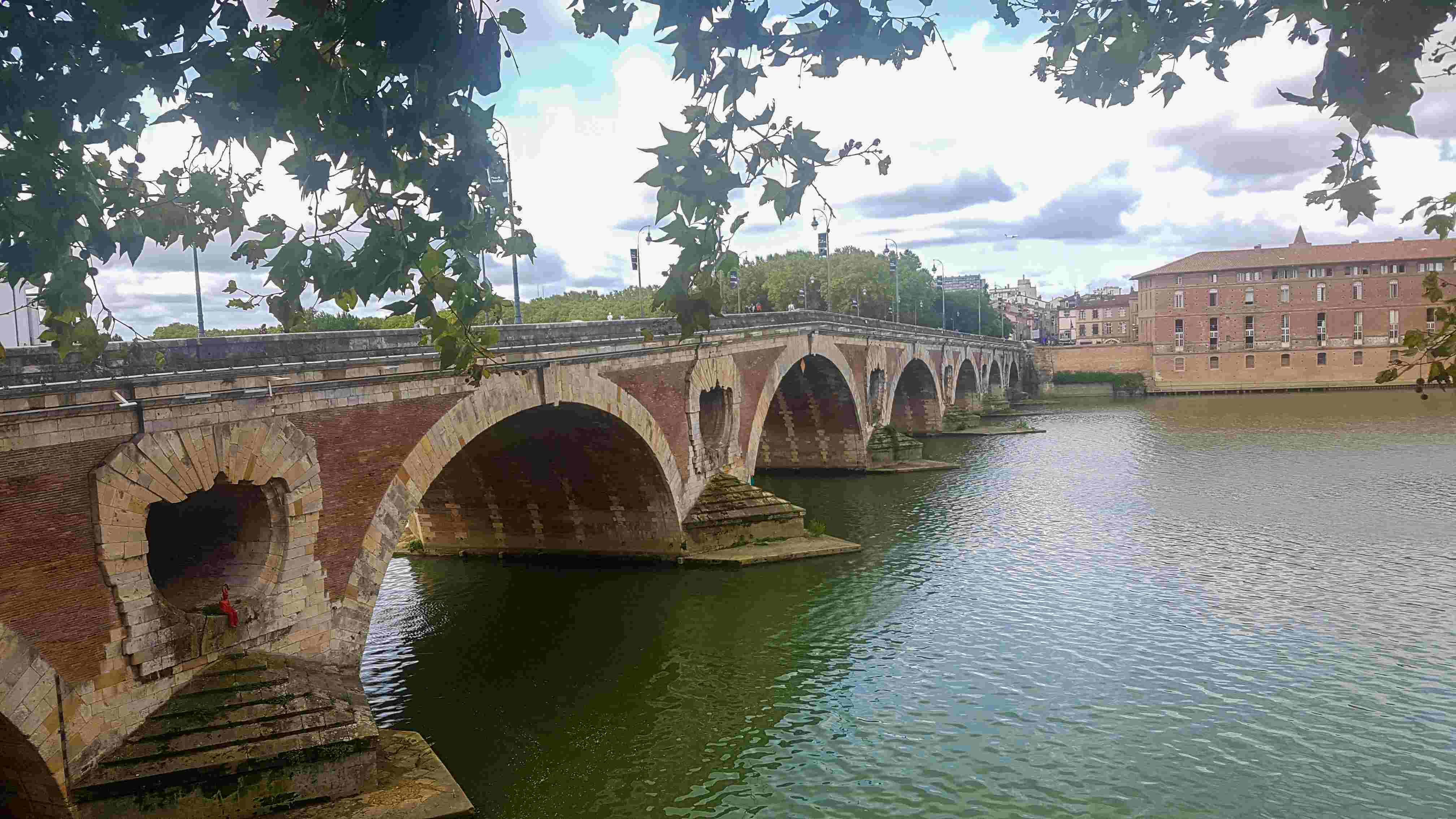
Toulouse is the fourth largest city in France and is also known as the ‘Pink City’, where you’ll see plenty of buildings built with pale-colored bricks.
The city offers plenty of art, culture, history, and of course, mind-blowing gastronomy. Toulouse is the perfect place to try some delicious cuisine from the French countryside.
Did you know that the headquarters of European Airbus and the French space agency are located in Toulouse? If you are a space enthusiast, check out the City of Space.
You’ll have the whole day to wander around the city at your own pace. Explore the sights, sounds, and flavors of the city. The food here is some of the most divine French cuisine.
Top attractions in Toulouse include:
- Toulouse Cathedral
- Canal du Midi
- Place du Capitol
- Basilique Saint-Sernin
- Cité de l’Espace
Here’s a Toulouse sightseeing tour you may want to explore.
Day 13: Bordeaux
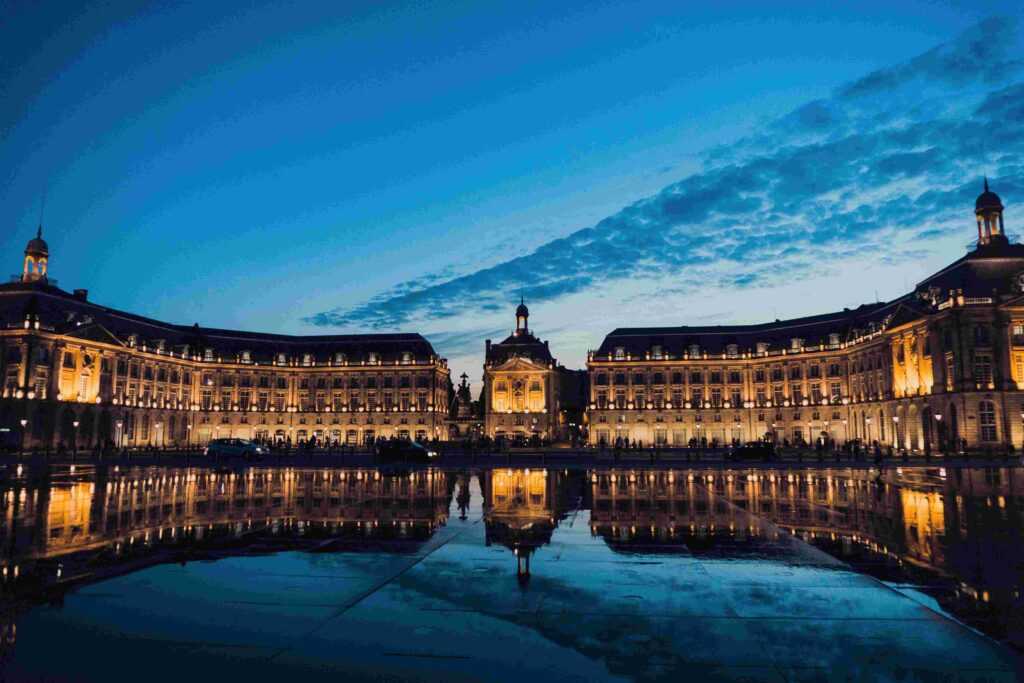
The end of the Southern France road trip is nearing. You’ll spend your last two days in the heart of France’s most famous wine lands, Bordeaux, the world’s wine capital.
Bordeaux is mainly known for its delicious wine but the city is also so beautiful with outstanding architecture. It reminded us a lot of Paris, without the same level of mass tourists.
Bordeaux is a very walkable city and the majority of the city’s best sights are based in and around the city centre. Once you arrive, the first thing you’ll notice is the spectacular Miroir d’eau in front of the Place de la Bourse. The Water Mirror creates a beautiful square.
Did you know around 80% of the land around Bordeaux is used for wine production? And aren’t you just lucky enough that you’ll get to taste some of that delicious wine!
Top attractions in Bordeau
- Place de la Bourse
- La Grosse Chloche
- Pey Berland Tower
- Cathédrale Saint-André
- Grand Théâtre de Bordeaux
- Quais de Bordeaux
- La Cité du Vin
- Pont de Pierre
Don’t forget to try ‘canneles’ – a local French dessert that originated here. It’s a rum and vanilla-flavored pastry with custard cream in the middle and a caramelized crust. Delicious!!
Explore Bordeaux by yourself or take a guided tour. On your final day tomorrow, you’ll take a day trip and visit some of the wineries.
Day 14: Bordeaux
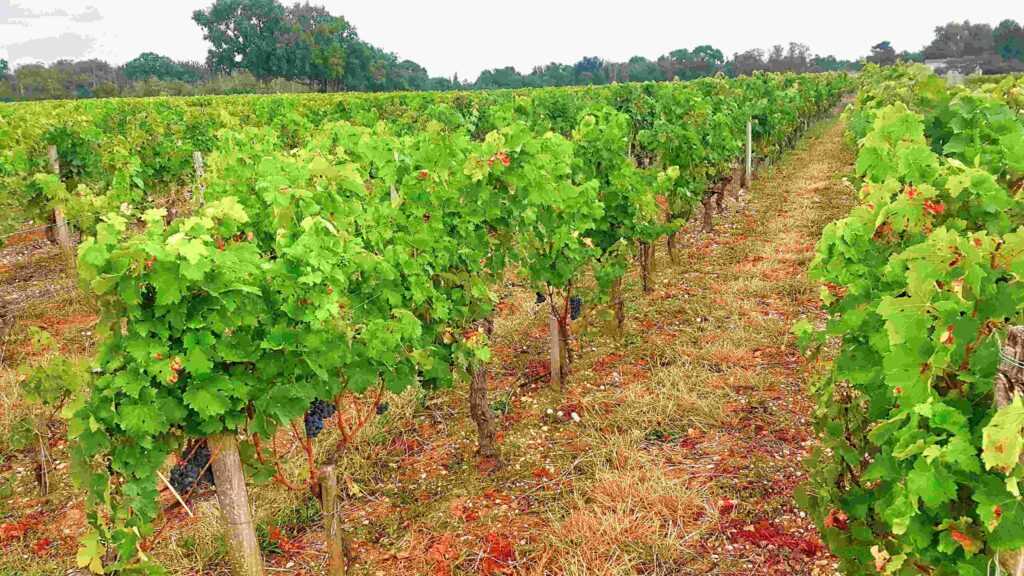
Today you’ll explore some of the famous wine locations in southern France. Whether you are wine tasting or visiting a small little village, you are in for a treat. St. Emilion village is the most popular, charming town that is surrounded by some of Bordeaux’s most famous vineyards. You will also visit Medoc and Graves, two more popular towns in this region.
If you plan to visit more than one place, we would recommend either driving or taking a guided tour. You can check them out here. The good thing about a guided tour is the transportation from and back to Bordeaux is included, so you don’t have to worry about a thing. During these guided tours, you’ll experience real wine production and will get to taste some of the world’s best wine classes.
Enjoy your last evening in Bordeaux before you fly out.
That concludes this spectacular two-week South of France road trip. The purple fields of lavender, delectable food, and beautiful landscapes make your two weeks in the South of France one of the most enjoyable experiences.
This itinerary covers what we did on a two-week itinerary in the South of France. These are our insights and travel tips that will help you make the most of these regions and are meant as a guide to help your French road trip planning.
Happy Travels!
If you have more time
If you have more time in this region, I’d suggest spending a few more days in Bordeaux. Explore Archacon Bay and Dunes de Pilat in Arcachon. The dreamy beaches and delicious seafood make it a nice way to escape from the hustle and bustle of Bordeaux.
If you are driving there, the car park is located just 400m from the dunes.
Dunes de Pilat is the tallest sand dune in Europe. It gets 2 million visitors per year and when you visit this place you’ll see exactly why. The views from up top are spectacular. And if you are feeling a bit adventurous you can surf down on a bodyboard.
You can also drive a bit further and visit Basque country. It’s a part of France that is so underrated. You have a mix of beautiful seaside towns like Biarritz, Bilbao, and Bayonne and quaint villages such as Espelette and Saint Jean de Luz amongst others.
South of France Travel Guide
Best Time for a South of France Road Trip
There is no bad time to visit the South of France as it has something unique to offer any time of the year. But it’s best to plan ahead so you can make the most of your time while visiting.
The summer months between June and August are peak seasons which means higher prices and larger crowds all around. The locals also tend to take this time off and holiday in the region, making beaches and other tourist spots incredibly crowded.
September sees the end of peak season and tourism starts to quieten down. It’s generally a good time to visit southern France. The region isn’t as crowded and the temperatures are still warm during the day. If you do plan to visit the lavender fields, which is one of the highlights in Provence, you’ll need to plan your trip between June and the end of July. This is when the lavender fields are fully in bloom. By August, you’ll miss the lavenders in bloom.
How long do you need in the South of France?
In a perfect world, you could spend weeks or even months exploring all the hidden treasures in the South of France. But if you have two weeks in the South of France, you’ll be able to cover a reasonable amount. I’d say allow a minimum of two weeks to make it a worthwhile trip. Anything less will seem like a rush.
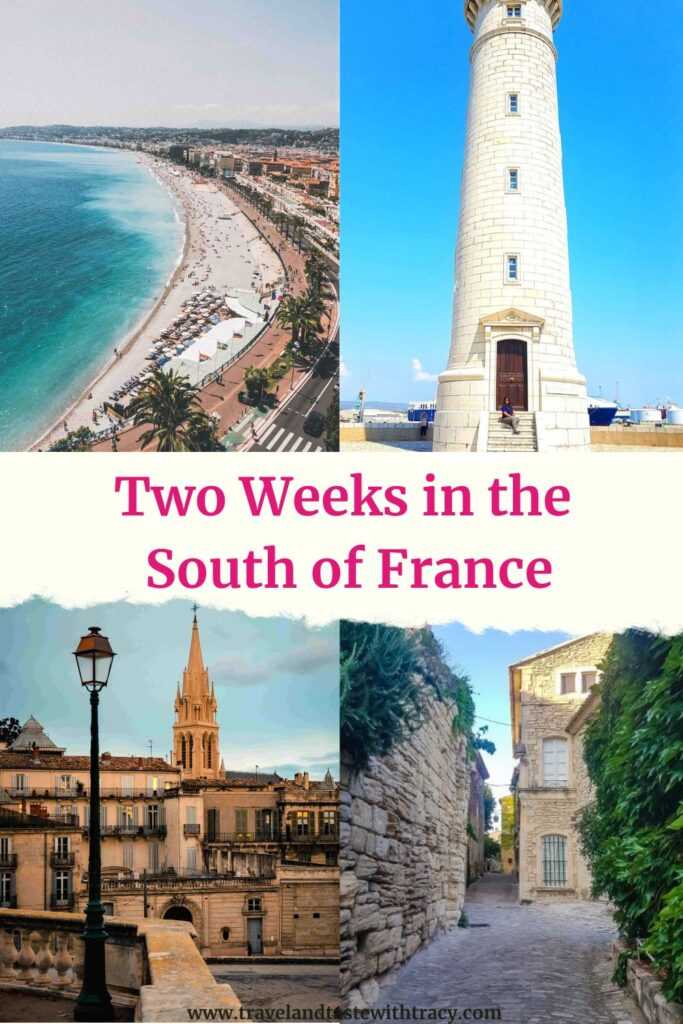
Tips for Planning Your South of France Road Trip
Decide where you will fly into
There are a few big airports you can fly into in this region, Nice, Toulouse, Marseille, and Bordeaux. You could fly into and out of Nice or either one of the other cities. Having a plan helps you structure your trip. We chose to fly into Nice as we were making our way from Eastern Europe. So, it made more sense for us to do it that way. We’d recommend checking flight costs to see which cities provide a cheaper option to fly in and out of.
Rent a car
While transport is great in France and you can use trains and buses to move between larger cities, if you really want to see some of the smaller towns and villages, we would highly recommend renting a car. In our opinion, it’s the best way to get around the South of France and find some of those hidden treasures.
Now I’m not saying you absolutely must rent a car, but what I will say is that renting a car to make your way through the South of France will be a convenient and enjoyable experience. While you may be able to get to some places by train or bus, it’s those hidden gems that you’ll miss out on if you don’t have your own vehicle. Plus, you have the added luxury of stopping as many times as you like and heading to any location your heart desires rather than being dependent on a tour. Just make sure you get insurance and a small car to make your way through some of the narrow roads.
Most highways in France are subject to road tolls. You pay at the Toll Gates, either by cash or by credit card. Make sure you’re in the right lane at these toll booths! Look for the ‘$’ and coins signs, which means you can only pay by cash at that Toll Booth. Card payments will be accepted at the toll booths under the card symbol.
You can rent through several internationally well-known companies. We leased our car as we were traveling through Europe for a number of months so it made better economic sense to lease for the duration.
Don’t change accommodation constantly
Base yourself in a couple of locations rather than constantly moving from hotel or Airbnb at each new place you visit. One thing we’ve learned from being on the road for months at a time is you don’t have to move each time you want to see another town or city. Sometimes basing yourself in a central location could have you well set to discover the towns and villages in the area.
Packing and unpacking your belongings, checking in and out of your hotels and/or apartments, loading and unloading the car, all these things take up more time than you might think. So, try and limit the number of times you have to move your accommodation. We’d recommend changing accommodation every 3 to 4 days if possible. Structure your trip so you can do more day trips from your base location. Choose accommodation in one part of each region. Keep in mind that this will only work if you have your own vehicle and are planning your itinerary.
Take time into consideration
Plan ahead so that you can get the most out of your time in the South of France. If you have an itinerary to follow you more or less know how much time you can spend in each place.
Note: The information here is updated the best we can at the time of writing this article. Please check attractions, activities, and transport before you can as things tend to change from time to time.

